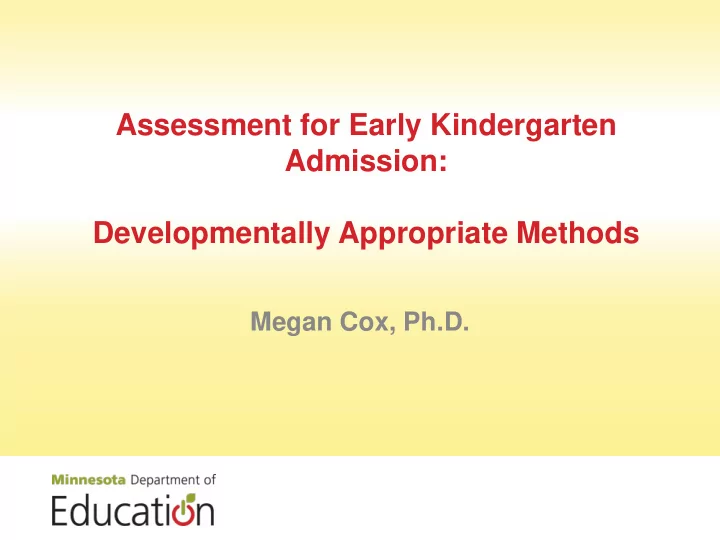

Assessment for Early Kindergarten Admission: Developmentally Appropriate Methods Megan Cox, Ph.D.
Revisit Early Entrance Statute If established, a board-adopted early admissions policy must describe the process and procedures for comprehensive evaluation in cognitive, social, and emotional developmental domains to help determine the child's ability to meet kindergarten grade expectations and progress to first grade in the subsequent year . The comprehensive evaluation must use valid and reliable instrumentation, be aligned with state kindergarten expectations , and include a parent report and teacher observations of the child's knowledge, skills, and abilities. The early admissions policy must be made available to parents in an accessible format and is subject to review by the commissioner of education. The evaluation is subject to section 127A.41 .
First, some ethical considerations… • Above all, do no harm – We shall not participate in practices that discriminate against children by denying benefits, giving special advantages, or excluding them from programs… – We shall involve all those with relevant knowledge of the child… – We shall use appropriate assessment systems which include multiple sources of information… NAEYC code of ethics, 2005
What is comprehensive evaluation? • Multiple developmental domains • Includes multiple sources of information • Aligns to standards or agreed upon criteria
Some context… Within any population, you can assume normal distribution
Must be across multiple domains…
Foundational knowledge and skills • Persistence and task orientation • Enthusiasm for learning • Knowledge of letters and correct grammar • Manages feelings and emotions in appropriate ways • Creativity • Attention / flexible memory
Multiple domains • Questions – Can you get cognitive and social/emotional- Within one assessment? Bundled assessments? – What are the trade-offs? Cost Convenience Training
Best practice in early childhood assessment • Assessment needs to be – Reliable – Valid – Standardized & Individualized • Assessment needs to occur – In familiar settings with familiar adults – Have multiple sources of data – Include parent report as integral part • Assessors need to know – Typical child development – The child as an individual – Multiple domains of learning and development
Reliability, Validity & Standardization Are not always equal to “norm - referenced” or “achievement ” • Standardized – Administered the same way each time it is administered regardless of administrator • Reliability – Internal consistency – Inter-rater • Validity – Construct – Concurrent – Predictive
Keep in mind… • A one-time snapshot of a child entering a kindergarten classroom cannot capture all of the cumulative experiences in programs, in the home, and in the community of a young child from birth to that day in kindergarten (Snow, 2013). • What standards does your district deem critical for success in first grade? Second grade? Third?
Familiar adults, settings and tasks • Parent input should be first line of inquiry – Many EC assessments have this built in • Child’s early childhood provider or teacher – Can produce evidence of child’s likely achievement – Can relay information to K teachers • Child’s early childhood classroom/environment – Set up functional tasks that approximate needed skills
What about adaptations? • Child from culturally or linguistically diverse background? – Interpreters – Assessment that is translatable – Functional tasks that are culturally appropriate
How do you know the assessment is aligned to K expectations • What are the kindergarten expectations? – Early Learning standards (beginning of K) – Kindergarten standards (end of K) • Each have multiple domains that need to be included • Procedure in place for assuring alignment? – Alignment studies – Expert panel / informed opinion
Alignment studies Sample questions for experts • How well does this assessment align to the ECIPS and K standards? – Not aligned ( less than 50% of items align) – Partially aligned (50% to 79% of items align) – Fully aligned (80% or more of items align) • In your opinion, do the standards align along a developmental continuum? – If you answered not aligned or partially aligned, please indicate the gap in alignment overall and how to fill
Recommendations for assessment procedures • Include multiple assessors/inputs – Child’s preK teacher, parent, K teacher from district • Conduct the assessment in familiar settings – Child’s ECE program or other familiar place (home) • Use both functional tasks and direct assessment • Consider executive function and social/emotional readiness with equal weight to cognitive
Scenario Parent consults early educators Parent Request Early Entry Child is observed in natural environment Child observed by kindergarten and assessment staff Additional testing as necessary
Points for consideration Handout
Questions/ Comments Policy Questions Debbykay Peterson Debbykay.Peterson@state.mn.us Assessment Questions Megan Cox Megan.Cox@state.mn.us
Recommend
More recommend